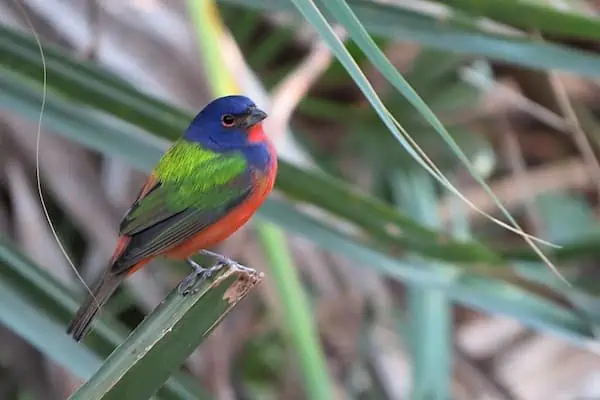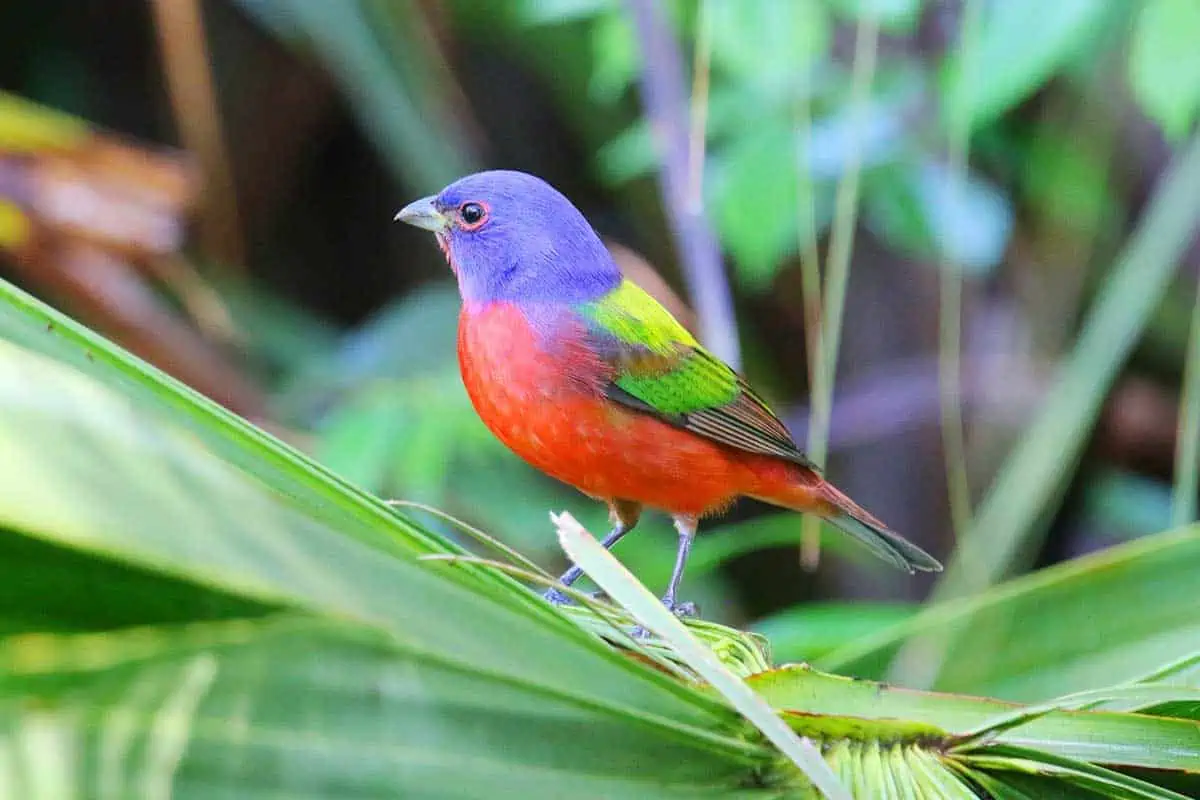The spring and fall migration seasons are the most exciting for most birder. We get a chance to see different bird species during these months that don’t spend the entire year in the US. The Painted Bunting is a sought-after species for birdwatchers in the southeastern United States. To help you understand more about Painted Buntings’ behaviors and habits, we explore some fascinating facts in this article.
FACTS ABOUT PAINTED BUNTINGS
1. MALES AND FEMALES ARE DIFFERENTLY COLORED
Males and females of Painted Buntings have distinct plumage, indicating that they are sexually dimorphic. Females are more plain but still colorful than males, who are multicolored with bright and vivid colors.
The head of a male Painted Buntings is blue, with a crimson eye-ring, crimson from the neck to the belly, and greenish-yellow on the upper back. They have a watercolor appearance. Adolescent birds and females, on the other hand, are a uniform greenish-yellow that ranges from fairly dull to quite bright. The pale circle surrounding the eyes of females and juvenile Painted Buntings may also be seen.

2. THE COLORING OF THE MALES HAS EARNED THEM MANY NICKNAMES
The Painted Bunting is one of North America’s most colorful birds, and it has long been considered so. The Painted Bunting is known as “siete colores” in Mexico, which translates to “seven colors.” In Louisiana, they are referred to as “nonpareil,” which means “without equal.”
3. PAINTED BUNTINGS SPEND THE SUMMER IN THE UNITED STATES
Painted Buntings go to two major breeding locations in the spring and summer. Northern Mexico, Texas, Oklahoma, Arkansas, Louisiana, and western Mississippi are among the mid-south states with a western population. The second breeding habitat, or eastern population, is located in northern Florida, Georgia, and Carolina’s southern coastal areas.
4. PAINTED BUNTINGS MIGRATE SOUTH FOR THE WINTER
Painted Buntings migrate south when the weather becomes chilly. They spend the winter in Central America, the Caribbean, Cuba, and southern Florida.
5. PAINTED BUNTINGS PREFER RURAL HABITATS
Scrub-marsh environments are preferred by painted buntings. Several people may find these environments to be “unkempt” or “unruly,” which is their own term for it. They’re most frequently seen in wooded areas, with scattered bushes and weed patches. Because of its semi-open environment, the bird may fly with its flock and be protected from predators at the same time.
Painted Buntings, on the other hand, are only able to access this kind of environment when they are on the coast. As a consequence, they’ve learned to exploit scrublands-dominated environments and geography. Wooded dunes, fallow farm fields, and yards with a lot of shrubs are all possible examples.

6. THEY TIME THEIR MOLTING WITH MIGRATION
In the early fall, right before heading south, the western population of Painted Buntings begins to molt. The birds then come to a halt in northern Mexico to rest. Before moving south, they will complete their molt here. Waterfowl have a tendency to follow this pattern, but songbirds don’t.
Surprisingly, before heading south, the eastern population’s molt is complete.
7. PAINTED BUNTINGS HAVE HISTORICALLY BEEN CAPTURED FOR THEIR COLORS
The practice of painting buntings and selling them for their beauty has been going on for a long time. Thousands of painted buntings were captured every spring then delivered from New Orleans to Europe, according to Audubon in 1841. Although it is now prohibited, this technique, particularly in Mexico and Central America, continues to be practiced illegally.
The Gouldian Finch, another very colorful songbird, has a similar destiny.
8. PAINTED BUNTINGS WILL VISIT BIRD FEEDERS
These buntings visit bird feeders and enjoy sunflower and seed blends, while not as common as some other songbird species in the backyard. They prefer to stay hidden in shrubby habitat, so having thick bushes in your lawn will increase their likelihood of coming. As we previously mentioned, they like to remain somewhat disguised.

9. PAINTED BUNTINGS DIET DEPENDS ON THE SEASON
For most of the year, painted buntings are granivores that consume seeds and grains. They, however, alter their diet and begin eating a lot of insects like grasshoppers, beetles, caterpillars, flies, and weevils during mating season.
10. PAINTED BUNTINGS ARE CONSIDERED A SOCIAL SPECIES DURING THE WINTER
Painted Buntings may be seen in small flocks throughout the winter months. They may be seen foraging alongside painted buntings, as well as other seed-eating bird species. However, during the breeding season, which brings us to fact #11, being a friendly neighbor changes dramatically.

11. MALE PAINTED BUNTINGS ARE HIGHLY TERRITORIAL DURING THE BREEDING SEASON
Males aggressively protect their territory, which is roughly 3 acres in size, when the breeding season begins. Other males may be fiercely attacked by them, resulting in lost feathers, injuries, and even death. Even girls aren’t exempt from their aggressive behavior. That is, until they need to court and find their mate.
12. MALES DISPLAY FOR FEMALES
Men attempt to get on the females’ good side and impress them as soon as courting begins. They’ll spread out and show off their feathers to the females. During the breeding season, which runs from April to August, this species is predominantly monogamous.
13. FEMALES BUILD THE NEST
While both sexes work together to locate a suitable nesting location, the females do the majority of the construction. Mulberry, elm, Spanish moss, myrtle, and pine are all common nesting plants. Twigs, grasses, roots, and weed stems are bound together with cobwebs to make nests.
14. FEMALE PAINTED BUNTINGS TAKE CARE OF THE YOUNG ON THEIR OWN
Before hatching, the female lays 3-4 eggs and spends around 10-12 days incubating them. The offspring will stay in the nest for 12-14 days before departing, and the female takes care of them by herself. She will lay a second brood around 30 days after her first eggs hatch.
15. MALES SING TO ESTABLISH TERRITORY
A brief, high-pitched musical sound is the Painted Bunting’s song. Males will fly between multiple perches and sing 9-10 songs every minute in the spring while establishing territory. Males in the neighborhood frequently “counter-singe,” or sing back and forth.
